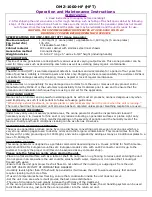
7
Model
A+B+C+D
Amount of additional refrigerant charge (kg)
30 m and less
31-40 m
41-50 m
51-60 m
61-70 m
71-80 m
No additional
charge necessary
Calculate the amount of additional refrigerant
charge using formula provided next page
HRP200
For single combination
(1 indoor unit)
For twin / triple /
quadruple combination
(2-4 indoor units)
1.4 kg
2.8 kg
0.9 kg
1.8 kg
4.2 kg
5.6 kg
7.0 kg
4. Installing the refrigerant piping
Stop valve <Liquid side>
Stop valve <Gas side>
Service port
Open/Close section
Local pipe
Sealed, same way for gas side
Pipe cover
Do not use a wrench here.
Refrigerant leakage may result.
Use 2 wrenches here.
Fig. 4-5
Fig. 4-6
Fig. 4-7
4.4. Refrigerant pipe airtight testing method (Fig.4-5)
(1) Connect the testing tools.
•
Make sure the stop valves
are closed and do not open them.
•
Add pressure to the refrigerant lines through the service port
of the liquid
stop valve
.
(2) Do not add pressure to the specified pressure all at once; add pressure little by
little.
Pressurize to 0.5 MPa (5 kgf/cm
2
G), wait 5 minutes, and make sure the pres-
sure does not decrease.
Pressurize to 1.5 MPa (15 kgf/cm
2
G), wait 5 minutes, and make sure the
pressure does not decrease.
Pressurize to 4.15 MPa (41.5 kgf/cm
2
G) and measure the surrounding tem-
perature and refrigerant pressure.
(3) If the specified pressure holds for about 1 day and does not decrease, the pipes
have passed the test and there are no leaks.
•
If the surrounding temperature changes by 1°C, the pressure will change by
about 0.01 MPa (0.1 kgf/cm
2
G). Make the necessary corrections.
(4) If the pressure decreases in steps (2) or (3), there is a gas leak. Look for the
source of the gas leak.
4.5. Stop valve opening method
The stop valve opening method varies according to the outdoor unit model. Use the
appropriate method to open the stop valves.
(1) Gas side (Fig. 4-6)
Remove the cap, pull the handle toward you and rotate 1/4 turn in a counter-
clockwise direction to open.
Make sure that the stop valve is open completely, push in the handle and rotate
the cap back to its original position.
(2) Liquid side (Fig. 4-7)
Remove the cap and turn the valve rod counterclockwise as far as it will go with
the use of a 4 mm hexagonal wrench. Stop turning when it hits the stopper.
(ø9.52: Approximately 10 revolutions)
Make sure that the stop valve is open completely, push in the handle and rotate
the cap back to its original position.
Refrigerant pipes are protectively wrapped
•
The pipes can be protectively wrapped up to a diameter of ø90 before or after
connecting the pipes. Cut out the knockout in the pipe cover following the groove
and wrap the pipes.
Pipe inlet gap
•
Use putty or sealant to seal the pipe inlet around the pipes so that no gaps re-
main. (If the gaps are not closed, noise may be emitted or water and dust will
enter the unit and breakdown may result.)
4.6. Addition of refrigerant
•
Additional charging is not necessary if the pipe length does not exceed 30 m.
•
If the pipe length exceeds 30 m, charge the unit with additional R410A refriger-
ant according to the permitted pipe lengths in the chart below.
*
When the unit is stopped, charge the unit with the additional refrigerant
through the liquid stop valve after the pipe extensions and indoor unit have
been vacuumized.
When the unit is operating, add refrigerant to the gas check valve using a
safety charger. Do not add liquid refrigerant directly to the check valve.
*
After charging the unit with refrigerant, note the added refrigerant amount on
the service label (attached to the unit).
Refer to the “1.5. Using R410A refrigerant air conditioners” for more informa-
tion.
•
Be careful when installing multiple units. Connecting to an incorrect indoor unit
can lead to abnormally high pressure and have a serious effect on operation
performance.
Double spanner section
(Do not apply a spanner other than to this section.
Doing so would cause coolant leaks.)
Seal section
(Seal the end of the heat insulation material at
the pipe connection section with whatever seal
material you have on hand so that water does not
infiltrate the heat insulation material.)
Valve
Unit side
Handle
Cap
Local pipe side
Pipe cover
Service port
Wrench hole
Precautions when using the charge valve (Fig.4-8)
Do not tighten the service port too much when installing it, otherwise, the valve
core could be deformed and become loose, causing a gas leak.
After positioning section
in the desired direction, turn section
only and tighten
it.
Do not further tighten sections
and
together after tightening section
.
Warning:
When installing the unit, securely connect the refrigerant pipes before start-
ing the compressor
.
* The figure to the left is an example only.
The stop valve shape, service port position,
etc., may vary according to the model.
* Turn section
only.
(Do not further tighten sections
and
together.)
Charge hose
Service port
Fig. 4-8
(1)
(2)
Model
Permitted pipe
length
Permitted vertical
difference
Additional refrigerant charging amount
31 - 40 m
41 - 50 m
51 - 60 m
61 - 75 m
HRP71,100,125
-75 m
-30 m
0.6 kg
1.2 kg
1.8 kg
2.4 kg
Содержание PUHZ-HRP HA2
Страница 146: ......








































